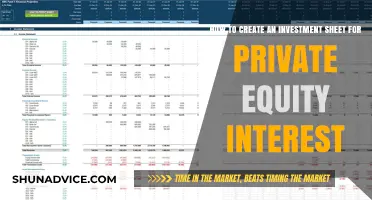
Investment management is a fascinating field that combines financial expertise with strategic decision-making. What truly interests me about this domain is the intricate interplay between market trends, economic indicators, and individual investor goals. It's about navigating the complex landscape of global markets, making informed decisions, and helping clients achieve their financial aspirations. The process involves a deep understanding of various investment vehicles, risk management strategies, and the ever-evolving regulatory environment. I'm particularly drawn to the challenge of optimizing investment portfolios, ensuring they are tailored to meet specific objectives while also adapting to the dynamic nature of financial markets. This field offers a unique opportunity to contribute to the financial well-being of individuals and institutions, making it a truly rewarding and intellectually stimulating pursuit.
What You'll Learn
- Portfolio Optimization: Strategies for maximizing returns while managing risk
- Market Analysis: Understanding trends, indicators, and economic factors to make informed decisions
- Risk Management: Techniques to identify, assess, and mitigate potential investment risks
- Investment Research: Methods for gathering and analyzing data to identify profitable opportunities
- Regulatory Compliance: Navigating legal and ethical standards in the investment industry

Portfolio Optimization: Strategies for maximizing returns while managing risk
In the realm of investment management, portfolio optimization stands as a cornerstone strategy, aiming to strike a delicate balance between maximizing returns and managing risk. This process involves a meticulous approach to asset allocation, where investors seek to create a diversified portfolio that aligns with their financial goals and risk tolerance. The primary objective is to design a portfolio that not only generates substantial returns but also ensures the preservation of capital and provides a sense of security for investors.
One of the key strategies in portfolio optimization is asset allocation, which involves distributing investments across various asset classes such as stocks, bonds, commodities, and real estate. The allocation is determined by the investor's risk appetite, investment horizon, and financial objectives. For instance, a conservative investor might allocate a larger portion of their portfolio to bonds and fixed-income securities, seeking stability and lower risk, while a more aggressive investor may opt for a higher allocation to stocks, aiming for higher potential returns.
Diversification is a critical component of this strategy. By spreading investments across multiple assets, sectors, and geographic regions, investors can reduce the impact of any single investment's performance on the overall portfolio. This approach mitigates risk by ensuring that the portfolio is not overly exposed to any one market or asset class. For example, a well-diversified portfolio might include a mix of large-cap and small-cap stocks, domestic and international equities, and various sectors like technology, healthcare, and energy.
Risk management is another essential aspect of portfolio optimization. Investors employ various techniques to assess and manage risk, such as value-at-risk (VaR) models, which estimate potential losses over a given time horizon. These models help investors set risk limits and make informed decisions about portfolio construction. Additionally, regular portfolio reviews and rebalancing are conducted to ensure that the asset allocation remains aligned with the investor's risk tolerance and objectives.
Active portfolio management is a strategy where investors make frequent adjustments to their holdings based on market analysis and research. This approach involves buying and selling assets to capitalize on market opportunities and manage risk. Active managers aim to outperform the market by identifying undervalued assets and making strategic decisions to optimize the portfolio's performance. However, this strategy requires skilled professionals and constant monitoring to ensure timely and effective decision-making.
In summary, portfolio optimization is a dynamic process that requires a comprehensive understanding of market dynamics, risk management techniques, and investor objectives. By employing asset allocation, diversification, and active management strategies, investors can construct portfolios that offer a compelling balance between risk and return. This approach is particularly appealing to investors seeking long-term wealth creation while maintaining a sense of control and security over their financial assets.
Unveiling the Power of Compounding: Which Investment Products Deliver?
You may want to see also

Market Analysis: Understanding trends, indicators, and economic factors to make informed decisions
Market analysis is a critical component of investment management, offering a comprehensive understanding of the financial markets and their dynamics. It involves a meticulous study of various trends, indicators, and economic factors that collectively shape investment opportunities and risks. This process is essential for investors and fund managers to make informed decisions, optimize portfolios, and navigate the ever-changing landscape of global markets.
At its core, market analysis aims to identify patterns and trends that can influence asset prices. This includes studying historical price movements, market volumes, and the behavior of various financial instruments. By examining these trends, investors can anticipate potential shifts in market sentiment and make strategic adjustments to their investment strategies. For instance, recognizing a prolonged upward trend in a particular industry might prompt investors to allocate more capital to that sector, anticipating further growth.
Technical indicators play a pivotal role in market analysis, providing quantitative metrics to assess market behavior. These indicators include moving averages, relative strength index (RSI), and moving average convergence divergence (MACD). By analyzing these indicators, investors can identify potential buy or sell signals, manage risk, and determine optimal entry and exit points for their trades. For example, a crossover of short-term and long-term moving averages is often considered a strong buy signal, indicating a potential upward trend.
Economic factors are another critical aspect of market analysis, as they provide a broader context for investment decisions. These factors encompass a wide range of variables, such as interest rates, inflation, GDP growth, and employment data. Understanding these economic indicators helps investors assess the overall health of the economy and its potential impact on specific industries and asset classes. For instance, rising interest rates might lead to a decrease in bond prices, while a thriving economy could boost the performance of growth-oriented stocks.
Moreover, market analysis involves a thorough examination of industry-specific trends and news. This includes monitoring regulatory changes, technological advancements, and competitive landscapes within various sectors. By staying abreast of these developments, investors can identify emerging trends, assess the competitive advantage of companies, and make more accurate predictions about future market performance. For example, the adoption of renewable energy sources might present opportunities in the energy sector, while advancements in artificial intelligence could impact multiple industries, creating both risks and rewards.
In conclusion, market analysis is a multifaceted discipline that empowers investors to make well-informed decisions. It involves a meticulous study of trends, technical indicators, economic factors, and industry-specific news. By mastering these elements, investors can navigate the complexities of the financial markets, optimize their portfolios, and achieve their investment objectives. Effective market analysis is a cornerstone of successful investment management, ensuring that strategies are aligned with the ever-evolving market dynamics.
Interest Expense: A Clarification of Its Nature as an Investing Activity
You may want to see also

Risk Management: Techniques to identify, assess, and mitigate potential investment risks
Risk management is a critical component of investment management, as it directly impacts the success and sustainability of an investment strategy. Effective risk management involves a systematic approach to identifying, assessing, and mitigating potential risks that could impact an investment's performance. Here are some techniques to navigate this essential aspect of investment management:
Risk Identification: The first step is to recognize and define the various types of risks associated with an investment. This includes market risks, such as fluctuations in stock prices, interest rate changes, and economic cycles. It also encompasses credit risks, which relate to the financial health and creditworthiness of the investee. Additionally, consider operational risks, which involve potential losses from internal processes, human error, or system failures. Identifying these risks is crucial as it sets the foundation for the subsequent assessment and mitigation processes.
Risk Assessment: Once risks are identified, the next step is to evaluate their potential impact and likelihood. This assessment involves analyzing historical data, market trends, and industry-specific factors to estimate the probability and severity of each risk. For instance, a thorough credit analysis of a potential investment in a company would involve examining its financial statements, management team, and industry position to gauge the risk of default. Similarly, market risk analysis might include studying past market volatility and its impact on the investment's performance. This assessment helps in prioritizing risks and allocating resources effectively.
Risk Mitigation Strategies: After identifying and assessing risks, investors can employ various techniques to minimize their potential impact. One common approach is diversification, which involves spreading investments across different asset classes, sectors, or geographic regions to reduce the overall risk exposure. For example, a well-diversified portfolio might include a mix of stocks, bonds, and alternative investments. Another strategy is to use financial derivatives, such as options or futures, to hedge against specific risks. For instance, an investor might buy put options to protect against potential declines in stock prices. Additionally, regular risk monitoring and review are essential to ensure that the investment strategy remains aligned with the risk tolerance and objectives of the investor.
Quantitative and Qualitative Analysis: Effective risk management utilizes both quantitative and qualitative methods. Quantitative analysis involves using statistical models and historical data to measure and manage risks. For instance, Value at Risk (VaR) models estimate the potential loss of an investment portfolio over a given time horizon and confidence interval. Qualitative analysis, on the other hand, focuses on non-numerical factors, such as industry trends, regulatory changes, and geopolitical events, which can significantly impact investments. Combining these approaches provides a comprehensive understanding of the risk landscape.
Regular Review and Adaptation: Risk management is an ongoing process that requires regular review and adjustment. Market conditions, economic trends, and external factors can change rapidly, necessitating a dynamic risk management strategy. Investors should schedule periodic reviews to reassess risks, especially after significant market events or when new information becomes available. This iterative process ensures that the investment strategy remains robust and adaptable to changing circumstances.
From Debt to Wealth: My Journey to Investing
You may want to see also

Investment Research: Methods for gathering and analyzing data to identify profitable opportunities
Investment research is a critical component of the investment management process, and it involves a systematic approach to gathering and analyzing data to identify profitable investment opportunities. Effective research methods are essential for making informed decisions and managing investment portfolios successfully. Here are some key methods and strategies for conducting thorough investment research:
- Fundamental Analysis: This is a traditional and widely used approach in investment research. It involves studying and evaluating the intrinsic value of a company or asset by examining various financial and economic factors. Fundamental analysts delve into a company's financial statements, including income statements, balance sheets, and cash flow statements, to assess its financial health, growth prospects, and competitive advantage. They analyze key metrics such as revenue, earnings, profitability margins, debt levels, and industry trends. By comparing these factors with industry peers and historical data, investors can identify undervalued stocks or assets with strong growth potential. This method requires a deep understanding of financial ratios, industry dynamics, and macroeconomic factors.
- Technical Analysis: In contrast to fundamental analysis, technical analysis focuses on studying historical market data and price movements to predict future price trends. It involves the use of charts, statistical indicators, and various tools to identify patterns and trends in asset prices. Technical analysts believe that market prices reflect all available information and that past price and volume data can provide valuable insights for future trading decisions. They use techniques like moving averages, relative strength index (RSI), exponential moving averages, and candlestick charting to identify support and resistance levels, potential trend reversals, and entry/exit points for trades. While technical analysis is often used in trading and short-term investment strategies, it can also provide valuable insights for long-term investors to understand market sentiment and potential price movements.
- Quantitative Research: This method involves using mathematical and statistical models to analyze large datasets and identify patterns or correlations. Quantitative analysts employ advanced algorithms and computer programs to process vast amounts of data quickly. They may use factors such as price, volume, financial ratios, and macroeconomic indicators to build predictive models. Quantitative research is particularly useful for risk management, portfolio optimization, and identifying systematic investment strategies. For example, factor investing, which identifies and invests in specific factors like value, momentum, or quality, relies heavily on quantitative research to uncover profitable opportunities.
- Market and Industry Analysis: Understanding the broader market and industry dynamics is crucial for investment research. This includes studying economic indicators, market trends, regulatory changes, and industry-specific factors that can impact investment performance. Market analysis involves assessing supply and demand dynamics, interest rates, inflation, and geopolitical events that may influence asset prices. Industry analysis focuses on evaluating the competitive landscape, market share, product/service offerings, and growth prospects of companies within a particular sector. By staying updated on market and industry news, investors can anticipate potential risks and opportunities and make more informed investment decisions.
- Company Visits and Due Diligence: Conducting on-site visits to companies and performing thorough due diligence is an essential part of investment research. This method allows investors to gather first-hand information, assess management quality, and understand the company's operations and strategies. Due diligence may include reviewing company documents, conducting interviews with management, visiting facilities, and analyzing business processes. It provides a comprehensive understanding of the company's strengths, weaknesses, and potential risks. This approach is particularly valuable for private equity investments, real estate, or companies with unique business models.
Effective investment research requires a combination of these methods, tailored to the specific investment objectives and risk tolerance of the investor. It is an iterative process that involves continuous learning, staying updated with market trends, and adapting research strategies to changing market conditions. By employing these research methods, investors can make more informed decisions, identify profitable opportunities, and manage investment portfolios with a higher degree of confidence.
Negative Interest Rates: Incentivizing Investment or Hindering Growth?
You may want to see also

Regulatory Compliance: Navigating legal and ethical standards in the investment industry
The investment management industry is a complex and highly regulated sector, and ensuring compliance with legal and ethical standards is of utmost importance. Navigating this intricate landscape is a critical aspect of the role, as it directly impacts the integrity of the industry and the protection of investors' interests. Here's an overview of why regulatory compliance is a fascinating and essential part of investment management:
In the world of finance, regulations are the foundation that upholds market stability and investor confidence. These rules are designed to prevent fraud, ensure fair practices, and maintain the overall health of the financial system. Investment managers must stay abreast of an ever-evolving regulatory environment, which includes laws, guidelines, and standards set by various governing bodies. For instance, in the United States, the Securities and Exchange Commission (SEC) enforces regulations that require investment firms to disclose relevant information, maintain accurate records, and adhere to ethical conduct principles. Similarly, other countries have their own regulatory bodies with specific rules tailored to their financial markets.
One of the key challenges in regulatory compliance is keeping up with the frequent changes in legislation. Investment managers must be agile and proactive in their approach, as new laws and amendments can emerge unexpectedly. This requires a dedicated team of legal and compliance professionals who can interpret and implement these changes effectively. For example, the introduction of the European Union's MiFID (Markets in Financial Instruments Directive) and its subsequent updates has significantly impacted how investment firms operate across the region, requiring managers to adapt their strategies and reporting practices.
Ethical considerations are another critical aspect of regulatory compliance. Investment managers must ensure that their clients' interests are always prioritized and that all transactions are conducted with transparency and fairness. This includes avoiding conflicts of interest, providing accurate and timely information, and adhering to best practices in investment advice. Ethical conduct is not only legally required but also essential for building trust with clients and maintaining the reputation of the investment firm.
To navigate this complex environment, investment managers employ various strategies. They invest in comprehensive compliance software and tools to streamline reporting and monitoring. Regular training sessions are conducted to keep staff informed about regulatory changes and ethical standards. Additionally, firms often establish internal audit committees to review and assess compliance measures, ensuring that all processes are up-to-date and effective.
In summary, regulatory compliance in investment management is a dynamic and challenging field, requiring a deep understanding of legal frameworks and a strong commitment to ethical practices. It is a vital function that ensures the industry operates with integrity, protects investors, and contributes to the overall stability of the financial markets. Staying informed and adapting to regulatory changes is essential for investment managers to provide exceptional service while maintaining compliance.
Savings or Investments: Which Has the Lower Interest Rate?
You may want to see also
Frequently asked questions
My primary interest lies in the art of strategic decision-making and the intricate world of financial markets. I find the process of analyzing vast amounts of data, identifying trends, and making informed choices to be both challenging and rewarding. The ability to influence and grow wealth for clients is what drives my passion for this field.
Staying informed is crucial in investment management. I employ a multi-faceted approach. Firstly, I regularly review economic indicators, financial news, and industry reports. Secondly, I engage in continuous learning by attending seminars, conferences, and workshops. Lastly, I maintain a network of industry experts and mentors who provide valuable insights and keep me abreast of the latest developments.
Risk management is a critical aspect of investment management. I adopt a comprehensive strategy that involves identifying, assessing, and mitigating potential risks. This includes diversifying investment portfolios, employing statistical models to predict market movements, and regularly reviewing and rebalancing asset allocations. Effective risk management ensures the preservation of capital and the achievement of long-term investment goals.
A successful investment portfolio is a result of careful planning and customization. It involves understanding an investor's financial goals, risk tolerance, and time horizon. Diversification is key, spreading investments across various asset classes, sectors, and regions. Regular monitoring and adjustments are necessary to adapt to changing market conditions and ensure the portfolio aligns with the investor's objectives.
Building strong client relationships is essential for trust and long-term success. I prioritize clear and transparent communication, providing regular updates, performance reports, and market insights. I believe in active listening to understand client needs and preferences. By offering personalized advice and demonstrating a deep understanding of their financial goals, I aim to establish a collaborative partnership that fosters mutual growth.







